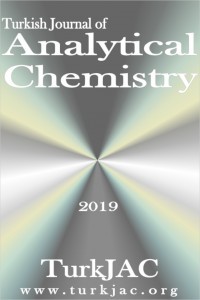HPLC analyses of polyphenolic compounds in oak (Querces frainetto) honey from Kırklareli region of Turkey
HPLC analyses of polyphenolic compounds in oak (Querces frainetto) honey from Kırklareli region of Turkey
In this study, phenolic profile and total phenolic contents of oak honeys, a kind of dark honeydew honey, was determined. The methanolic honey extract was enriched by liquid; liquid extraction with diethyl ether and ethyl acetate, and then was analyzed by RP-HPLC-UV with acetonitrile: water mobile phase. Nineteen phenolic standards were used to prepare calibration graphics. Seven phenolic acid (gallic acid, protocatequic acid, p-OH benzoic acid, caffeic acid, syringic acid, p-coumaric acid, ferulic acid) and twelve flavanoids (catechin, epicatechin, rutin, myerecetin, resveratrol, daidzein, luteolin, t-cinnamic acid, hesperetin, chrysin, pinocembrin, caffeic acid phenlyester (CAPE) were used. Total phenolic contents of the honeys were measured by Folic Ciocalteau's assay. All of the polyphenols except epicatechin, rutin, luteolin and hesperetin were detected in varying amounts of the honey samples. Protocatequic acid, ferulic acid, myricetin and chrysin were the most abundant phenolic compounds. Total phenolic contents of the honey were from 54 to 88 mg GAE/100 g. In summary, oak honey has a high apitherapeutic value with rich polyphenol diversity.
Keywords:
Antioxidant, Oak Honey,
___
- Referans 1 Simova, S., Atanassov, A., Shishiniova, M., Bankova, V. 2012. A rapid differentiation between oak honeydew honey and nectar and other honeydew honeys by NMR spectroscopy, Food Chem. 134(3), 1706-1710.Referans 2 Ozkok, A., Sorkun, K. 2018. Some characterıstıc features of oak (Quercus Frainetto Ten.) Fresenius Environmental Bulletin. 27, 8359-8366.Referans 3 Kolayli, S., Can, Z., Çakir, H. E., Okan, O. T., Yildiz, O. 2018. An investigation on Trakya region Oak (Quercus spp.) honeys of Turkey: Their physico-chemical, antioxidant and phenolic compounds properties. Turkish Journal of Biochem. 43(4), 362-374.Referans 4 Kim, K.H., Tsao, R., Yang, R., Cui, S.W. 2006. Phenolic acid profiles and antioxidant activities of wheat bran extracts and the effect of hydrolysis conditions. Food Chem. 95(3) 466-473.Referans 5 Slinkard, K., Singleton, V.L. 1977. Total phenol analyses: Automation and Comparison with Manual Methods. Am. Journal of Enol. Viticult. 28, 49-55.Referans 6 Fukumoto, L.R., Mazza, G. 2000. Assessing antioxidant and prooxidant activities of phenoliccompounds, Journal of Agric. Food Chem. 48, 3597-3604.Referans 7 Benzie, I.F.F., Strain, J.J. (1999). Ferric reducing/antioxidant power assay: direct measure of total antioxidant activity of biological fluids and modified version for simultaneous measurement of total antioxidant power and ascorbic acid concentration. Methods in Enzymol. 299:15-27.Referans 8 Çakır, H.E., Şirin, Y., Kolaylı, S., Can, Z. 2018.Validation Methods for Phenolic Components with RP-HPLC-UV in Various Bee Products. Apiterapi ve Doğa Dergisi, 1(1), 13-19.Referans 9 Muñoz, O., Copaja, S., Speisky, H., Peña, R.C., Montenegro, G. 2007. Contenido de flavonoides ycompuestos fenólicos de mieles chilenas e índice antioxidante. Quim. Nova, 30, 848–851.Referans10 Seijo, M. C., Escuredo, O., Rodríguez-Flores, M. S. 2019. Physicochemical Properties and Pollen Profile of Oak Honeydew and Evergreen Oak Honeydew Honeys from Spain: A Comparative Study. Foods, 8(4), 126.Referans 11 Sahin, H. (2016). Honey as an apitherapic product: its inhibitory effect on urease and xanthine oxidase. Journal of Enzyme Inhib. Med. Chem. 31(3), 490-494.Referans 12 Malkoç, M., Çakır, H.E., Kara, Y., Can, Z., Kolaylı, S. 2019. Phenolic Composition and Antioxidant Properties of Anzer Honey from Black Sea Region of Turkey. Uludag Arıcılık Dergisi, doi.org/10.31467/uluarıcılık.602906.Referans 13 González-Paramás, A. M., García-Villanova, R. J., Bárez, J. A. G., Sánchez, J. S., Albajar, R. A. 2007. Botanical origin of monovarietal dark honeys (from heather, holm oak, pyrenean oak and sweet chestnut) based on their chromatic characters and amino acid profiles. European Food Res. Technol.226(1-2), 87-92.Referans 14 Can, Z., Yildiz, O., Sahin, H., Turumtay, E. A., Silici, S., Kolayli, S. 2015. An investigation of Turkish honeys: their physico-chemical properties, antioxidant capacities and phenolic profiles. Food Chem. 180, 133-141.Referans 15 Malkoç, M., Kara, Y., Özkök, A., Ertürk, Ö., Kolaylı, S. 2019. Karaçalı (Paliurus spina-christi Mill.) Balının Karakteristik Özellikleri. Uludag Arıcılık Dergisi. 19(1), 69-81.Referans 16Yıldız, O., Can, Z., Saral, Ö., Yuluğ, E., Öztürk, F., Aliyazıcıoğlu, R., Kolaylı, S. 2013. Hepatoprotective potential of chestnut bee pollen on carbon tetrachloride-induced hepatic damages in rats. J. Evid Based Complementary and Altern Med. 461478:1-9.
- Yayın Aralığı: Yılda 2 Sayı
- Başlangıç: 2019
- Yayıncı: Miraç OCAK
Sayıdaki Diğer Makaleler
Abidin GÜMRÜKÇÜOĞLU, Nurhayat ÖZBEK, Tuğba AK, Elvan VANLI, Miraç OCAK, Ümmuhan OCAK
Yakup KARA, Zehra CAN, Sevgi KOLAYLI
Yasemin ÇAĞLAR, Ece Tugba SAKA
Production of propolis/TiO2 (P-TiO2) nano composites for degradation of food dyes
Melek KOÇ KEŞİR, Münevver SÖKMEN
Schiff base derivatives with morpholine and antioxidant activity
